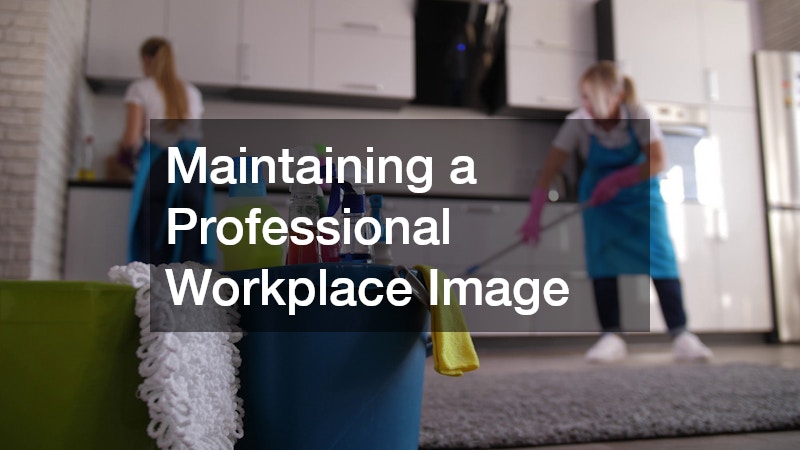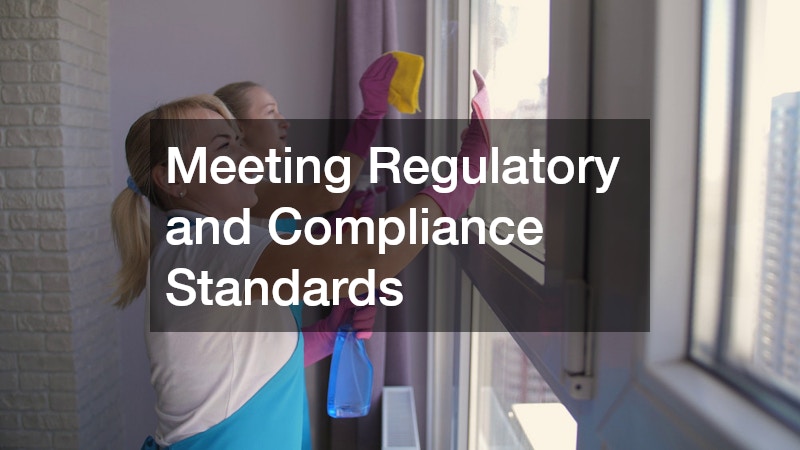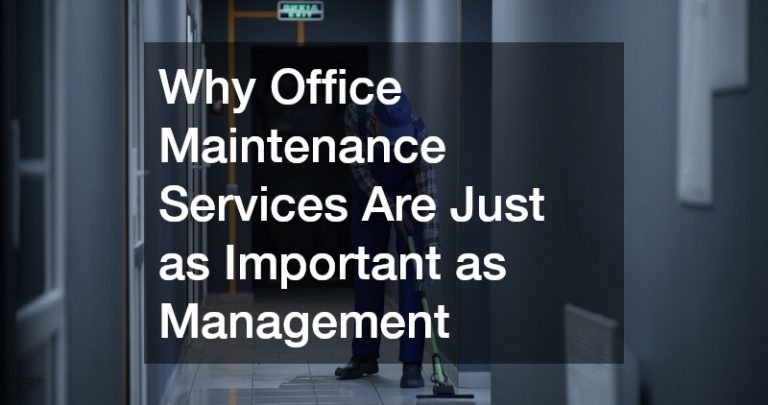In any professional setting, a workspace’s visible and functional quality speaks volumes about an organization’s priorities and values. While leadership and strategic management often take the spotlight, the behind-the-scenes efforts that keep an office running smoothly are equally critical. Office maintenance services ensure everything from lighting and air systems to floors and furnishings is in optimal condition. This consistent upkeep protects assets and creates an environment that supports productivity, morale, and long-term success. Without regular attention to these foundational elements, even the most skillfully managed workplace can quickly fall short of expectations.
Beyond aesthetics, maintenance’s true impact is felt in daily operations. Small unaddressed issues can evolve into significant disruptions affecting workflow, safety, and brand perception. By making maintenance a core part of operational planning, companies can safeguard the performance and reliability of their physical environment. In doing so, they create a stable foundation that empowers employees, impresses clients, and reinforces the organization’s commitment to excellence.
Regular upkeep also communicates an unspoken message to everyone who enters the space: this is a place where details matter. From a clean lobby to fully functioning meeting technology, every element of the workplace contributes to a seamless professional experience. By investing in office maintenance services as diligently as management processes, organizations demonstrate that operational excellence is a priority in every aspect of their business.
Maintaining a Professional Workplace Image

A well-maintained office sets the tone for every interaction that happens within it. From the moment someone steps through the door, the condition of the space communicates professionalism, attention to detail, and respect for those who work or visit there. Maintenance services help ensure that surfaces are spotless, lighting is balanced, and furniture is in good condition, all of which contribute to the overall perception of competence and care. A clean, orderly, and visually appealing environment is not a luxury—it’s a reflection of the company’s identity and priorities.
On a practical level, maintaining this standard can involve specialized approaches tailored to industry needs. For example, a company focused on industrial recycling may require extra attention to managing waste areas, ensuring proper equipment cleaning, and keeping designated work zones safe and compliant. By aligning office maintenance services with a business’s specific operational realities, organizations can uphold their professional image and address unique industry requirements without compromising efficiency or safety.
Ensuring a Safe and Healthy Environment
A safe workplace is essential for both legal compliance and the well-being of employees and visitors. Maintenance services contribute to this by ensuring that all systems, from electrical wiring to air filtration, function properly and meet safety regulations. Regular inspections, preventive repairs, and quick responses to emerging issues reduce the risk of accidents, equipment malfunctions, and environmental hazards. In turn, this creates a more reliable and supportive environment where people can focus on their work without unnecessary health or safety concerns.
When it comes to more specialized safety needs, certain businesses may require tailored solutions. For example, an organization using hydro excavation techniques may depend on precise cleaning, debris removal, and hazard mitigation to prevent accidents and maintain compliance. Integrating these specific tasks into broader office maintenance services ensures that both general and industry-specific safety needs are met consistently, reinforcing the company’s reputation as a responsible and diligent employer.
Extending the Lifespan of Office Assets

Office furniture, equipment, and infrastructure represent a significant investment for any organization. Maintenance services help protect that investment by ensuring that all assets are regularly inspected, cleaned, and repaired before small issues escalate into costly replacements. This proactive care extends the usability of items like chairs, desks, HVAC systems, and even technology infrastructure, which in turn reduces long-term expenses and supports smooth daily operations. By keeping everything in optimal condition, businesses avoid unnecessary disruptions and preserve both functionality and value.
In industries where specialized equipment is part of daily work, asset care becomes even more critical. For example, a company that relies on a voip phone service needs to ensure that wiring, connection points, and hardware remain in perfect working order. Office maintenance services can incorporate routine testing and upkeep for such systems, preventing outages that could impact client communication and operational efficiency. This combination of general upkeep and targeted care creates a stronger, more resilient workplace.
Enhancing Employee Productivity and Morale
The state of the workplace directly influences how employees feel and perform each day. Maintenance services play a vital role in creating an environment that is comfortable, functional, and free of avoidable frustrations. Proper lighting, clean workspaces, well-maintained restrooms, and reliable climate control all contribute to employee satisfaction. When staff members can focus on their tasks without being distracted by broken equipment or cluttered surroundings, productivity naturally increases.
Certain industries may find that integrating specific operational needs into their maintenance plans provides an added boost to workplace efficiency. In a batch manufacturing setting, for instance, ensuring that production-related areas remain clean, organized, and hazard-free supports both morale and workflow. This industry-specific attention, paired with ongoing office maintenance services, fosters a work culture where employees feel valued, supported, and equipped to do their best work.
A consistent investment in maintenance also signals to employees that their well-being is a top priority. When staff members see that their workspace is cared for, they are more likely to take pride in their own work and contribute to a positive culture. This creates a reinforcing cycle—well-maintained environments boost morale, and engaged employees help keep those environments in good condition. Over time, the combination of physical upkeep and employee engagement can lead to lower turnover rates and stronger team cohesion.
Reducing Unexpected Repair Costs

Unplanned repairs can place a significant strain on both budgets and schedules. By implementing a consistent schedule of inspections and preventive upkeep, office maintenance services help identify and resolve minor issues before they become major expenses. This approach allows businesses to plan for repairs in a controlled, budget-friendly way rather than scrambling to address sudden breakdowns. Over time, the savings from avoiding emergency fixes can be substantial, freeing up resources for other strategic priorities.
For example, businesses in the financial sector offering mobile lending services may depend heavily on uninterrupted access to their digital infrastructure. A failure in cooling systems, wiring, or other facility components could result in costly downtime. Incorporating these specific operational safeguards into regular maintenance services not only minimizes the risk of unexpected repairs but also ensures that business continuity is maintained without disruption.
Preventive care also allows businesses to negotiate better terms with service providers, as repairs and upgrades can be scheduled during non-peak hours rather than rushed in an emergency. This flexibility often results in lower labor costs and reduced disruption to daily operations. By weaving these proactive measures into a long-term facilities plan, companies can extend the life of their equipment, stabilize maintenance budgets, and ensure that office maintenance services contribute directly to financial predictability and operational resilience.
Supporting Sustainability and Energy Efficiency
A well-maintained office is not only functional but also environmentally responsible. Maintenance services contribute to sustainability by ensuring that systems operate at peak efficiency, reducing waste and energy consumption. From servicing HVAC units to sealing drafts and upgrading lighting, these efforts help lower utility costs and reduce the organization’s carbon footprint. Sustainable practices also align with modern corporate values, reinforcing a company’s commitment to environmental stewardship in the eyes of employees, clients, and partners.
Some industries may benefit from integrating technical expertise into their green initiatives. For instance, an engineering firm might work closely with maintenance teams to implement energy-saving technologies and fine-tune equipment for maximum efficiency. By combining specialized knowledge with the regular routines of office maintenance services, businesses can achieve measurable environmental benefits while maintaining operational excellence.
Meeting Regulatory and Compliance Standards

Compliance with safety, health, and industry-specific regulations is a non-negotiable aspect of running a business. Maintenance services play a vital role in ensuring that facilities meet required codes, undergo necessary inspections, and keep documentation current. This proactive approach minimizes the risk of penalties, legal challenges, or interruptions to business operations. By staying ahead of compliance requirements, organizations can operate with greater confidence and stability.
For example, companies that rely on crane services may face strict guidelines related to equipment safety, load management, and workplace conditions. Office maintenance services can work in tandem with operational teams to ensure that these areas are consistently monitored, maintained, and documented. This integrated approach helps keep both the office and specialized equipment in line with regulatory expectations, safeguarding both people and assets.
Improving Client and Visitor Impressions
First impressions often determine how clients, partners, and visitors perceive a business. A clean, organized, and well-functioning office space immediately communicates professionalism and attention to detail. Maintenance services ensure that reception areas, meeting rooms, and public spaces are always ready to welcome guests, free from clutter, damage, or disrepair. This attention to the physical environment supports a company’s broader reputation and strengthens relationships with key stakeholders.
Certain businesses may have unique needs in this area. For example, organizations that manage a septic cleaning service might need to ensure that their offices convey a clean, odor-free, and inviting atmosphere despite the nature of their fieldwork. By tailoring office maintenance to address such industry-specific challenges, businesses can consistently present a polished image that aligns with their brand identity and customer expectations.
Streamlining Daily Operations for Efficiency
A smoothly functioning workplace depends on more than just skilled employees and strong leadership—it also requires an environment where every system and resource works as intended. Maintenance services support this by preventing disruptions, ensuring essential supplies are stocked, and keeping equipment in peak condition. This consistent attention allows teams to focus on their core responsibilities instead of losing time to preventable issues like malfunctioning technology or disorganized spaces.
In certain industries, integrating operational needs into maintenance plans can be especially valuable. For instance, a real estate business promoting a property for sale may depend on well-maintained conference rooms, display areas, and client-facing spaces to make strong impressions during negotiations or presentations. Office maintenance services tailored to such requirements help ensure that every operational detail supports efficiency and professionalism.
Aligning Maintenance With Strategic Goals
Maintenance is not just about fixing what’s broken—it’s a strategic investment that supports broader business objectives. Maintenance services can be aligned with long-term plans for growth, branding, and resource management. This may include prioritizing upgrades that reflect the company’s values, improving spaces to attract top talent, or maintaining a consistent look and feel across multiple locations. When integrated into strategic planning, maintenance becomes a proactive driver of business success rather than a reactive cost.
For example, a plumber or plumbing business may want its office to showcase organization, reliability, and cleanliness—the same qualities it offers customers. By aligning office maintenance with these brand traits, the company reinforces its professional image while ensuring that its physical space supports its business goals. This alignment creates a unified experience for employees, clients, and partners alike.
Recognizing Maintenance as a Pillar of Success
While management often takes the spotlight in discussions of workplace success, it’s clear that maintenance services are equally indispensable. They form the foundation upon which daily operations, safety, and professional image are built. Without consistent upkeep, even the most well-managed organization can face inefficiencies, rising costs, and diminished credibility. The benefits of maintenance extend far beyond cleanliness—they protect investments, support compliance, and foster environments where people can thrive.
By integrating office maintenance services into strategic planning, businesses position themselves for long-term stability and growth. Each industry, from manufacturing to professional services, has unique needs that can be met through tailored maintenance strategies. When these services are prioritized alongside management, the result is a workplace that not only operates smoothly but also reflects the organization’s highest standards. This synergy between leadership and maintenance ensures that every part of the business is working toward the same vision of excellence.
Maintenance is not simply a background function—it is an active contributor to the company’s reputation, efficiency, and ability to adapt. In a competitive market, the organizations that recognize the equal importance of office maintenance and management will be the ones best positioned to thrive. By treating maintenance as a strategic pillar, businesses can create work environments that are not just functional but truly exceptional.

